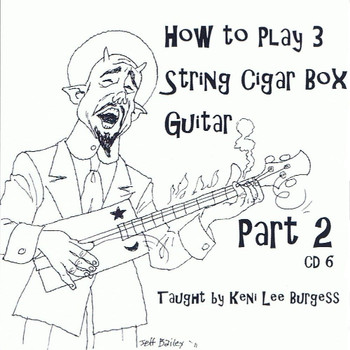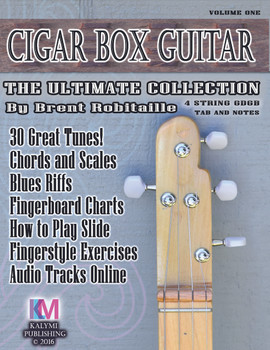Keni Lee Burgess
How to Play the 4-string Cigar Box Guitar - Video Lesson Pack from Keni Lee Burgess
- SKU:
- 21-003-01
Description
These lessons are perfect for beginners as a fun and educational method to learning music and playing guitar. Building and playing homemade instruments out of cigar boxes became popularized during the Great Depression of the 1930s and was a starting point for many famous musicans like Blind Willie Johnson, Lightnin Hopkins, Charlie Christian, Carl Perkins, Jimi Hendrix, George Benson, Roy Clark...
These video lessons are for a 4-string fretted instrument tuned D g b d: this includes 4-string cigar box guitars, tenor guitars and more.
This is a digital content purchase that entitles you to download a collection of files: 12 separate MP4 music files, and 3 ZIP files that must be decompressed/extracted to access the contents.
Lesson Descriptions:
- Lesson 1A - In this lesson, we will learn an arrangement of Robert Johnson's Come On In My Kitchen.
- Lesson 1B - In this next installment, we will continue our study of the second part of an arrangement of Robert Johnson's Come On In My Kitchen.
- Lesson 2 - A breakdown of an arrangement of Little Red Rooster by Willie Dixon and popularized by vocalist Howlin' Wolf.
- Lesson 3 - We will explore the single note lines that are used to accompany singing and the "call and response" fills that are used to play lead. The 5 note Minor Pentatonic Blues scale is presented in three positions to provide a framework for learning to create lead / melody lines against a 12 bar Blues progression. (Supplement Lesson B and C Jam track)
- Lesson 4 - Pentatonic scale exercises are presented to improve left hand movement and right-hand picking. A Blues arrangement is taught to demonstrate utilizing these ideas to create your own Blues song.
- Lesson 5A - To begin to understand how to build chords down the fingerboard, we will study the major scale and harmonizing two note doublestops on strings 2 and 3. These ideas will be applied to create Blues licks.
- Lesson 5B - Continuing with the previous lesson, we will examine the doublestops on strings 1 and 2. Skipping a string in between, we will also learn how to harmonize strings 1 and 3. These ideas will help clarify how to create fills while moving from chord to chord.
- Lesson 6 - To better organize the fingerboard, we will use the major scale to explore the location of three different triad chord inversions up and down the fingerboard. This will clarify the relationship between single notes from the major scale, two note (harmony) doublestops, and three note triad chords. Understanding this information will make finding chords and creating your own arrangements easier.
- Lesson 7 - In this lesson we will apply our knowledge of chords to learn an arrangement of the Blues Standard Stormy Monday.
- Lesson 8 - Taking chord theory further, we will learn how notes from the major scale are added to the basic chord triad to create extended chords like the major 7th, 7th, 6th, Suspended 4nd and Suspended 2th.
- Lesson 9 - To learn how to apply our knowledge, we will examine an arrangement of Freight Train.
- Lesson 10 - In this lesson, we will learn 11 licks in the style of Robert Johnson and understand how they can be strung together to form a complete 12 bar Blues song.
Supplement Lessons Descriptions:
- Lesson A - How to play Jingle Bells.
- Lesson B - A 12 bar Blues bass jam track to play against and practice lead licks learned in Lesson 3.
- Lesson C - Lead examples played against the 12 bar Blues bass jam track and a "Green Onions" jam example.
- Lesson D - How to play Stand By Me (8 bar Blues)
- Lesson E - How to play a Ragtime Blues arrangement.












